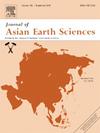Explosive ultramafic volcanism in Phanerozoic accreted terranes: A case study of the Taragai peridotite complex (Russian Far East)
IF 2.7
3区 地球科学
Q2 GEOSCIENCES, MULTIDISCIPLINARY
引用次数: 0
Abstract
In the Bureya accreted terrane of the Central Asian Orogenic Belt, the Taragai peridotite complex displays geologic characteristics of an explosive volcanic pipe. The crater-like, central topographic depression is composed of ultramafic pyroclastic rock that is surrounded by partially eroded tephra walls with imbedded peridotite blocks. Both peridotite blocks and ultramafic pyroclastics consist of olivine, orthopyroxene and spinel with minor phlogopite and display similar subduction-related geochemical characteristics. A certain degree of crustal contamination is suggested by highly radiogenic Sr isotope compositons of peridotites. LILE- and LREE-enriched basaltic dikes intrude ultramafic pyroclastic rocks. Peridotite blocks, ultramafic pyroclastic rocks and basaltic dikes contain three types of microspherules composed of 1) magnetite, 2) sulfide (mostly pyrrhotite) and 3) Cu-Ag-Au alloy. Magnetite microspherules reflect oxidation of sulfide in peridotite. Cu-Ag-Au microspherules were formed through re-melting of Cu-Ag-Au particles in peridotite blocks. Sulfide microspherules represent solidified droplets of sulfide melt generated during explosive emplacement of the Taragai complex. Assemblages of metals, alloys and ore minerals along with distribution of trace and ore elements in the Taragai peridotite complex are similar to the Ildeus ultramafic massif in the Stanovoy superterrane located to the northwest from the Bureya terrane. We propose that Taragai complex was formed as a result of a focused asthenospheric fluid flux from the flat-slab window beneath the Bureya terrane through the subduction-related ultramafic massif. Observed metallogenic features of the Taragai explosive volcanic complex thus may reflect contributions from mineralized ultramafic intrusive target, host accreted terrane rocks and asthenospheric fluid.
求助全文
约1分钟内获得全文
求助全文
来源期刊

Journal of Asian Earth Sciences
地学-地球科学综合
CiteScore
5.90
自引率
10.00%
发文量
324
审稿时长
71 days
期刊介绍:
Journal of Asian Earth Sciences has an open access mirror journal Journal of Asian Earth Sciences: X, sharing the same aims and scope, editorial team, submission system and rigorous peer review.
The Journal of Asian Earth Sciences is an international interdisciplinary journal devoted to all aspects of research related to the solid Earth Sciences of Asia. The Journal publishes high quality, peer-reviewed scientific papers on the regional geology, tectonics, geochemistry and geophysics of Asia. It will be devoted primarily to research papers but short communications relating to new developments of broad interest, reviews and book reviews will also be included. Papers must have international appeal and should present work of more than local significance.
The scope includes deep processes of the Asian continent and its adjacent oceans; seismology and earthquakes; orogeny, magmatism, metamorphism and volcanism; growth, deformation and destruction of the Asian crust; crust-mantle interaction; evolution of life (early life, biostratigraphy, biogeography and mass-extinction); fluids, fluxes and reservoirs of mineral and energy resources; surface processes (weathering, erosion, transport and deposition of sediments) and resulting geomorphology; and the response of the Earth to global climate change as viewed within the Asian continent and surrounding oceans.
 求助内容:
求助内容: 应助结果提醒方式:
应助结果提醒方式:


